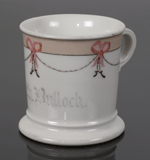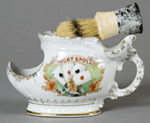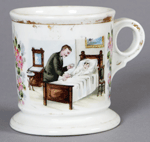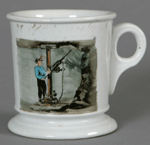|
Cowan's
Corner
Vintage Shaving Mugs Put Collectors in a Lather
By Wes Cowan
Before there were $200 electric shavers and 29¢ disposable razors, shaving
was an art complete with accoutrements like steamy hot towels, straight-edged
razors and shaving mugs. Americans started using shaving mugs shortly after the
Civil War and continued using them through the 1920s.
Barbershop shaving
mugs have become very collectable. For nearly 50 years, the local barbershop was
a kind of clubhouse for the working class. Barbers used hot towels, razors and
their own shaving mugs. Concerned about the sanitary issues of using communal
shaving apparatus, patrons began ordering personalized shaving mugs through
their barbers. These mugs were kept on a rack at the barbershop.
Shaving mugs
used in conjunction with hotel barbershops are also of value to collectors. Mugs
were located in the hotel's barbershop in the lobby and were marked with the
guest's room number. The guest would carry his mug to the barber and have his
shaving bill charged to his room.
The safety razor was invented around the
time of World War I when the Gillette razor was introduced to the American
troops. At that time, men began shaving at home, and a daily trip to the barber
became virtually obsolete.
Several companies in America specialized in
creating shaving mugs with the foremost being Koken Co. of St. Louis. Other
companies included J.R. Voldan (Cleveland), Harold Brothers (Cleveland), C.
Knecht (Chicago), Pabst & Kohler (Columbus), Philip Eisemann (Lancaster,
Pa.), R.H. Hegener (Minneapolis), B.S. Co. (St Louis), and N.W. Wilson Co.
(Portland, OR).
Today, there are four types of collectible shaving
mugs:
Decorated mugs. Originally from Staffordshire, England, France,
Germany, and Austria, decorated shaving mugs were rarely used until the late
1800s. When they became en vogue, the mugs themselves were manufactured in
Europe and decorated in the United States. Most of them were simple, hard paste,
white porcelain, and included the owner's name and a hand-painted overglazed
enamel decoration.
Occupational mugs. These shaving mugs cover virtually all
occupations with the majority representing the middle-class professions. The few
mugs that were designed for the lower- and upper-class professions make them a
rarity.
Fraternal mugs. Owned by members of fraternal organizations such as
the Elks Lodge, Odd Fellows, and Masons, fraternal mugs were decorated with
their owners' organization logos rendered in the paint.
Scuttle mugs. These
mugs have a ledge on one side, usually with three perforations, where the
gentlemen placed their shaving brushes. The holes allowed the water and the soap
to drain back into the mug.
 About the Author: Wes Cowan is founder and owner of Cowan's Auctions, Inc. in
Cincinnati, Ohio. An internationally recognized expert in historic Americana, Wes stars in
the PBS television series History Detectives and is a featured appraiser on Antiques
Roadshow. He can be reached via email at info@cowanauctions.com.
Article research by
Ted Sunderhaus.. About the Author: Wes Cowan is founder and owner of Cowan's Auctions, Inc. in
Cincinnati, Ohio. An internationally recognized expert in historic Americana, Wes stars in
the PBS television series History Detectives and is a featured appraiser on Antiques
Roadshow. He can be reached via email at info@cowanauctions.com.
Article research by
Ted Sunderhaus..
|

A shaving mug belonging to Seth Bullock, the first sheriff of Deadwood
$3,800. He became
sheriff the day after Wild Bill Hickok was shot.

Scuttle mug that sold for $57.50.

Shaving mugs with
rare depictions of
lower- and
upper-class jobs:
coal
miner (below), $1,955;
doctor (above), $2,300.

|